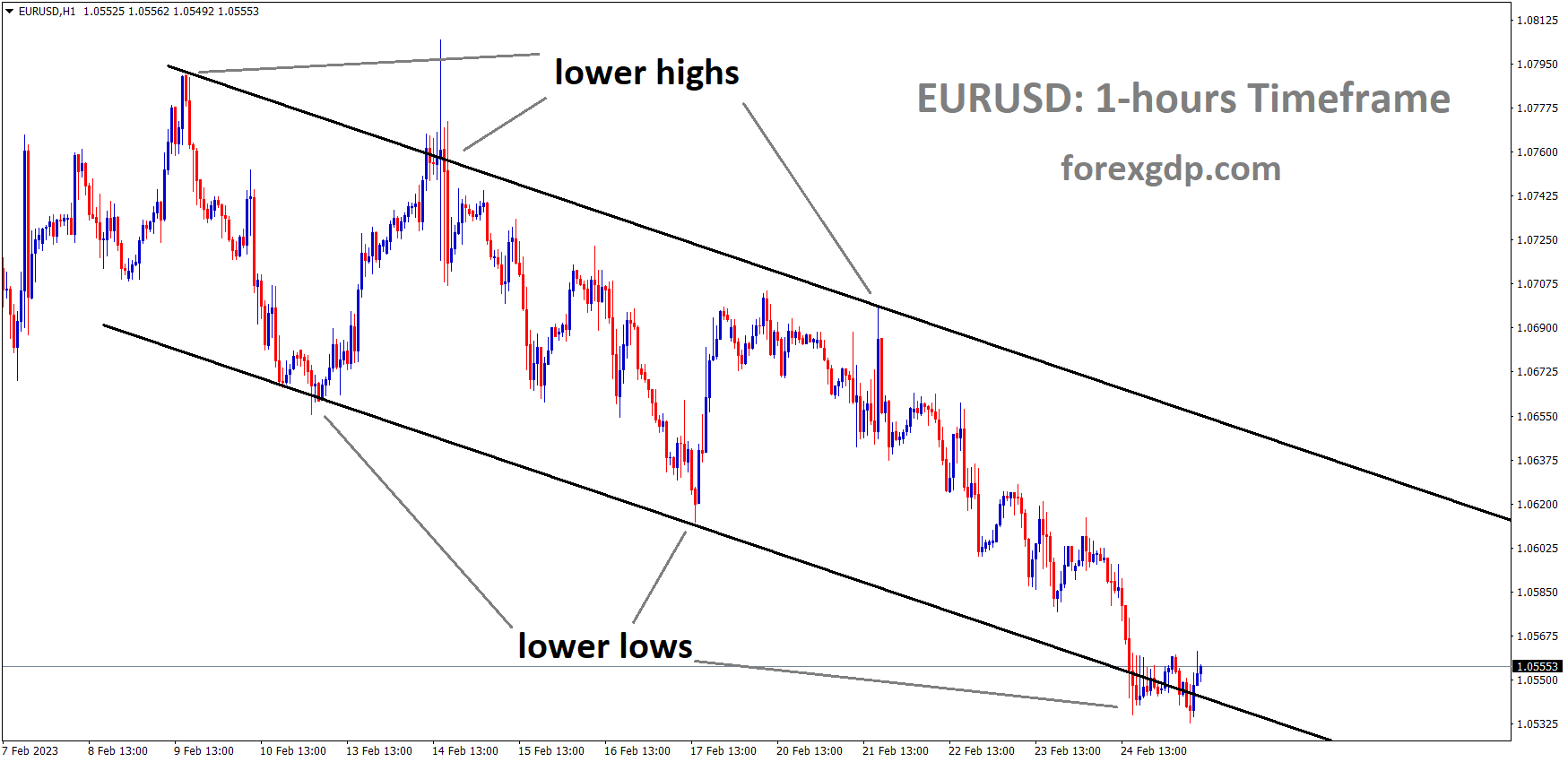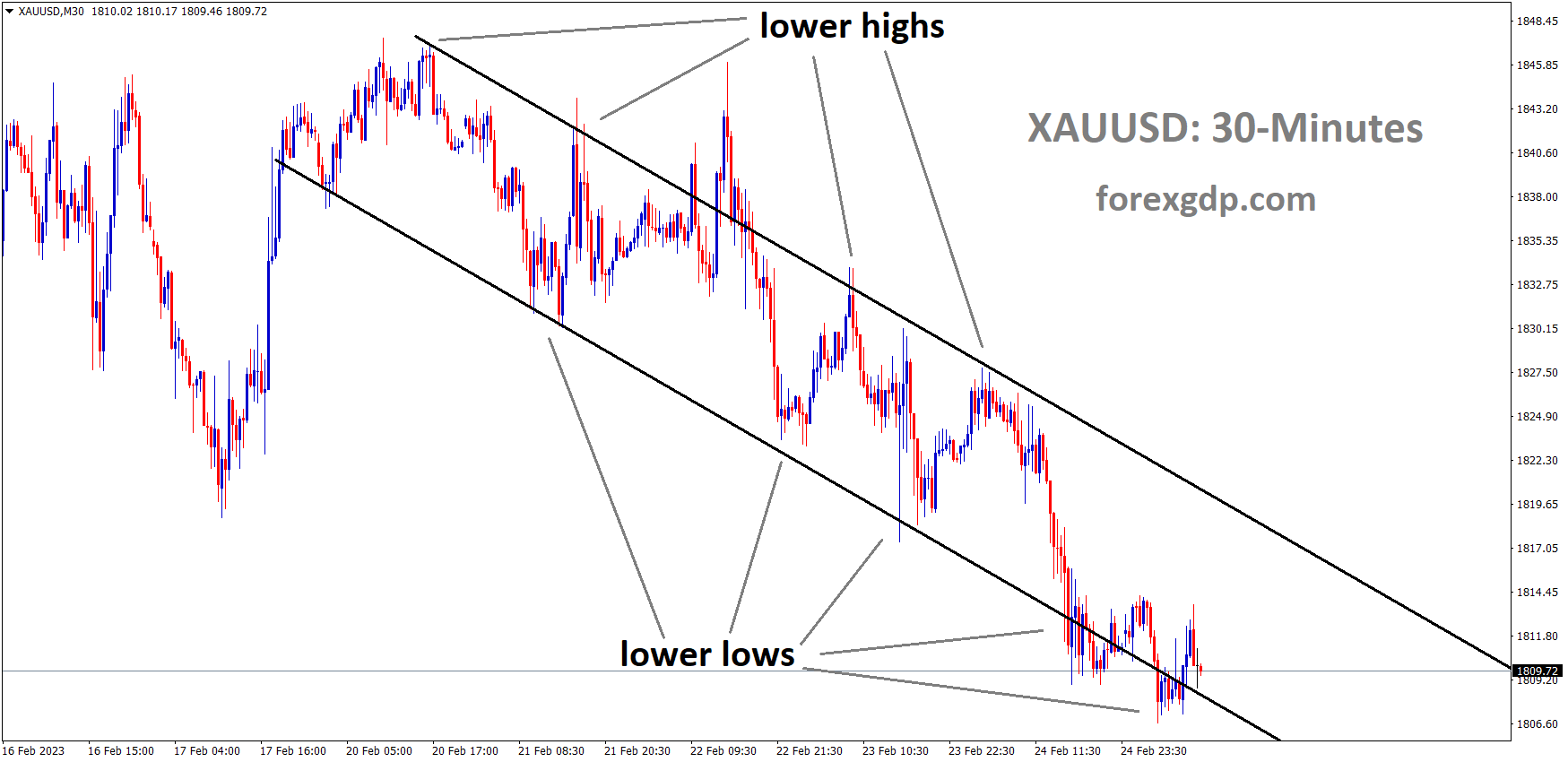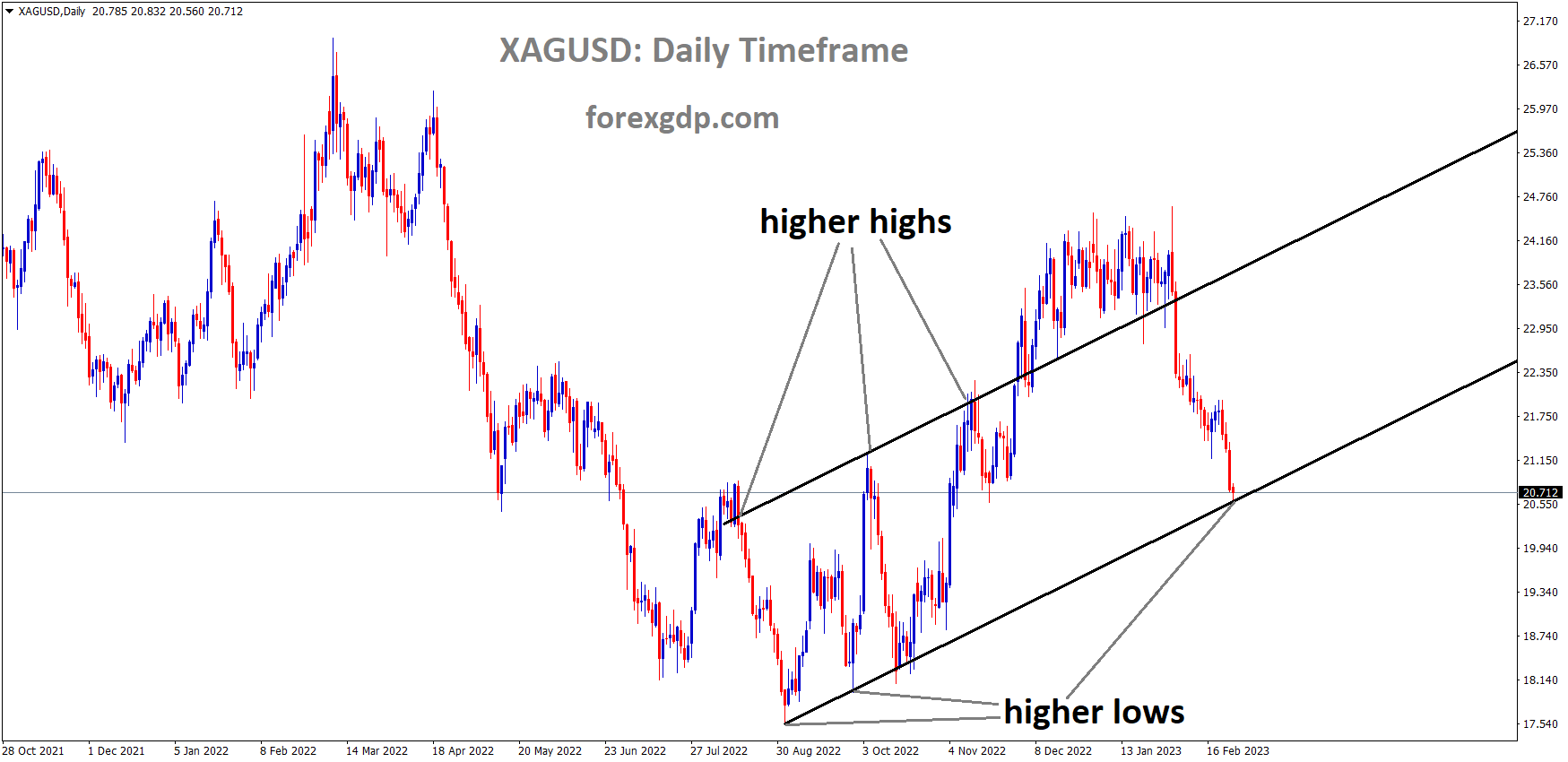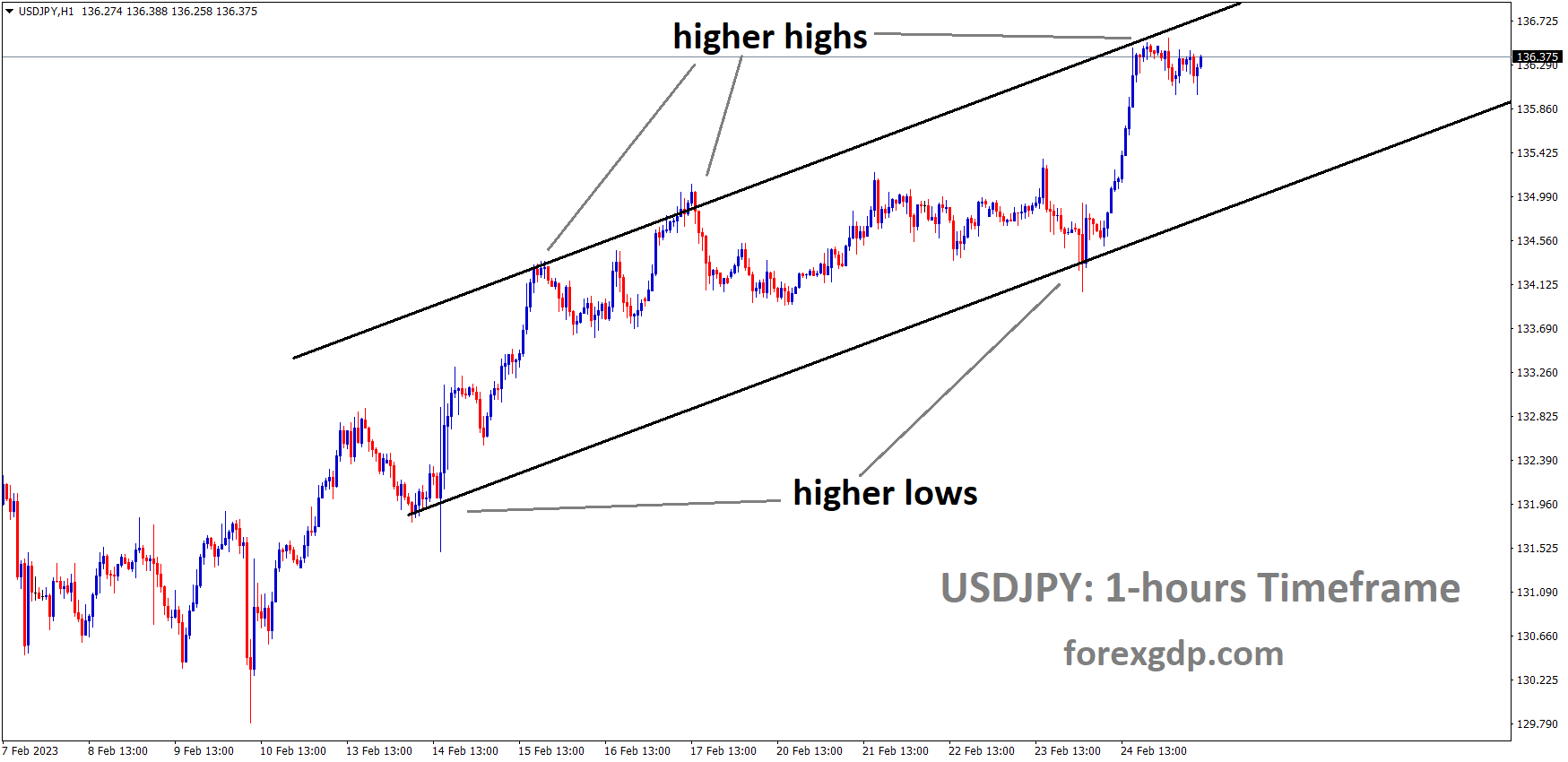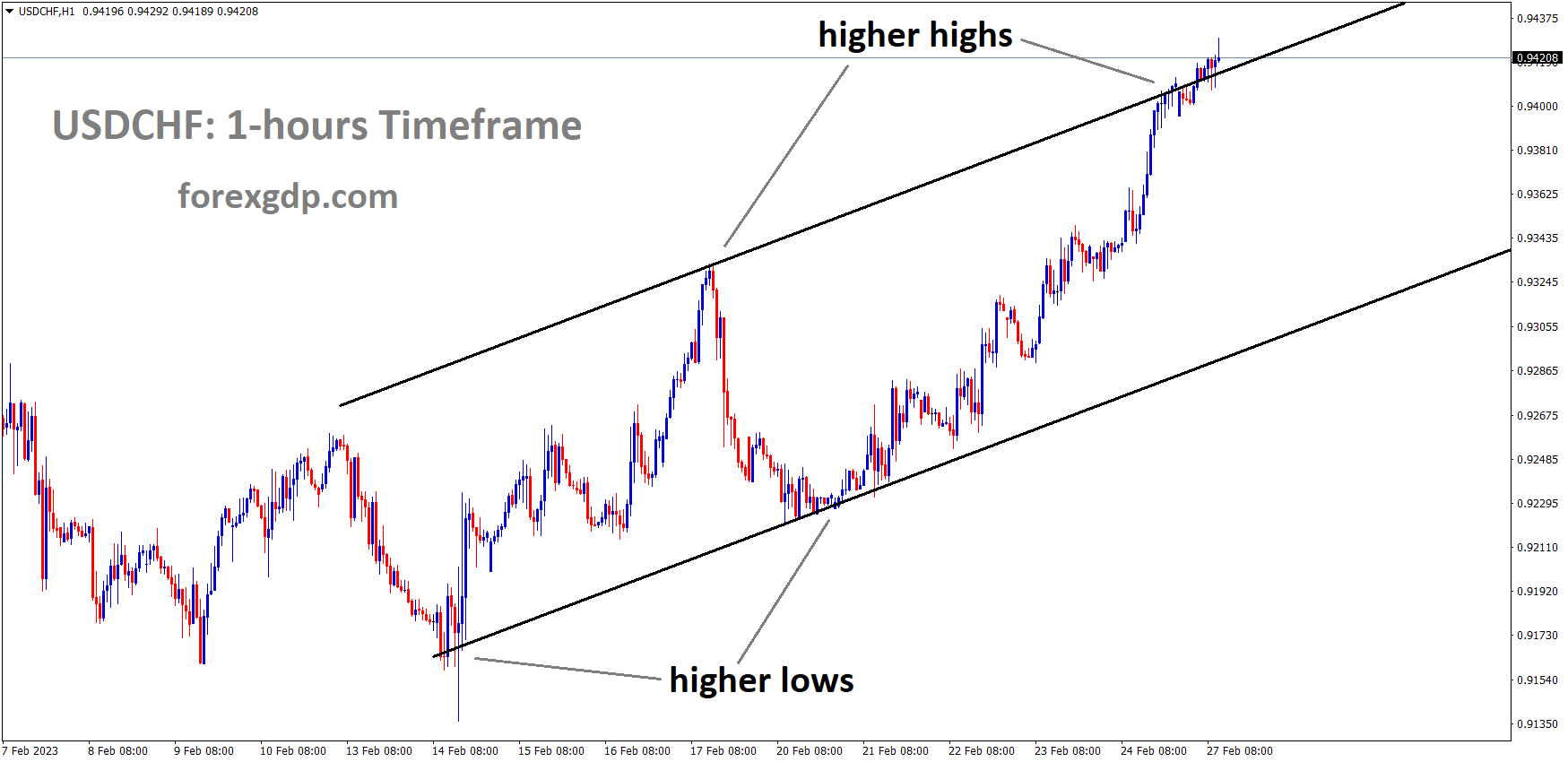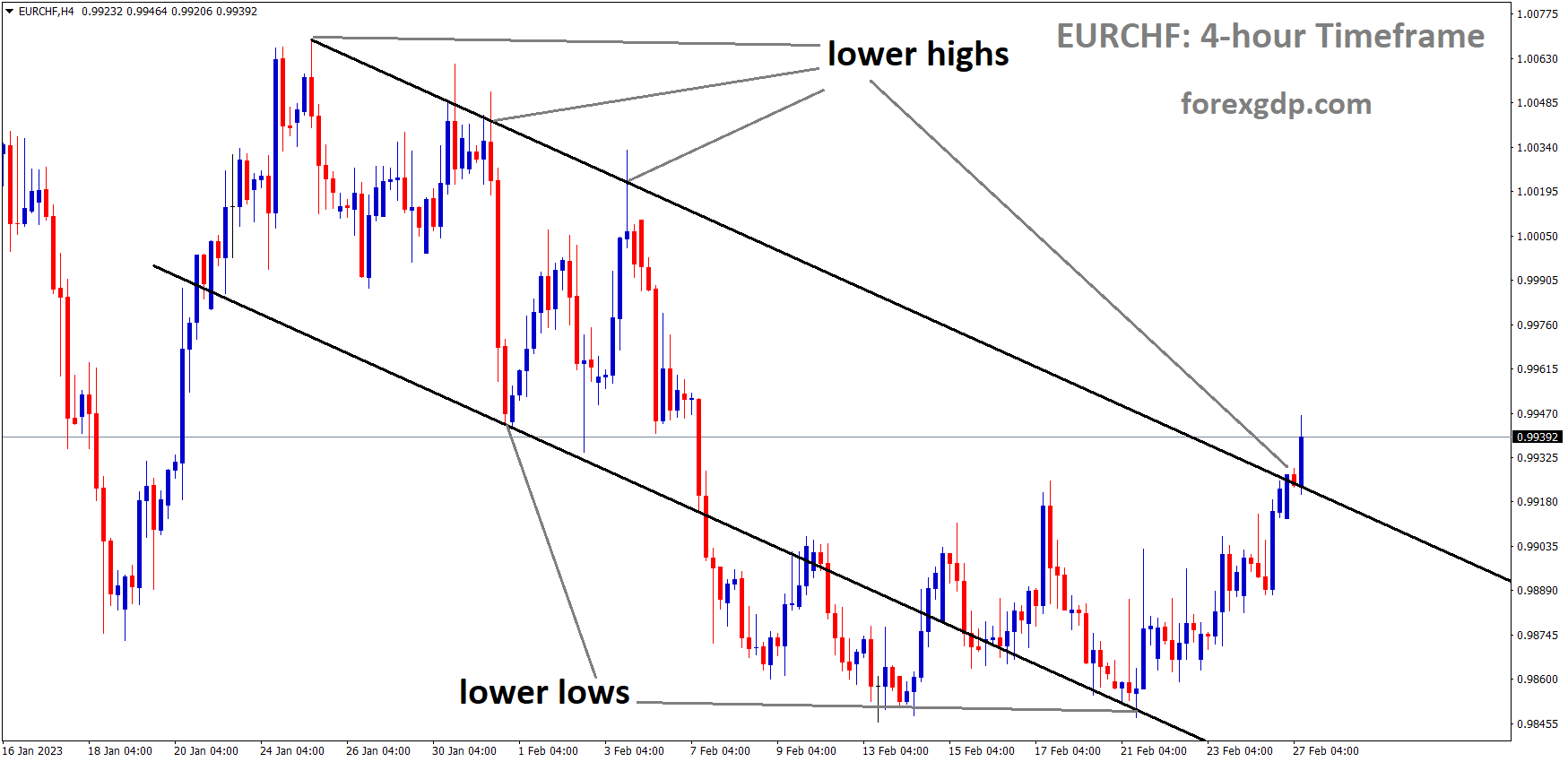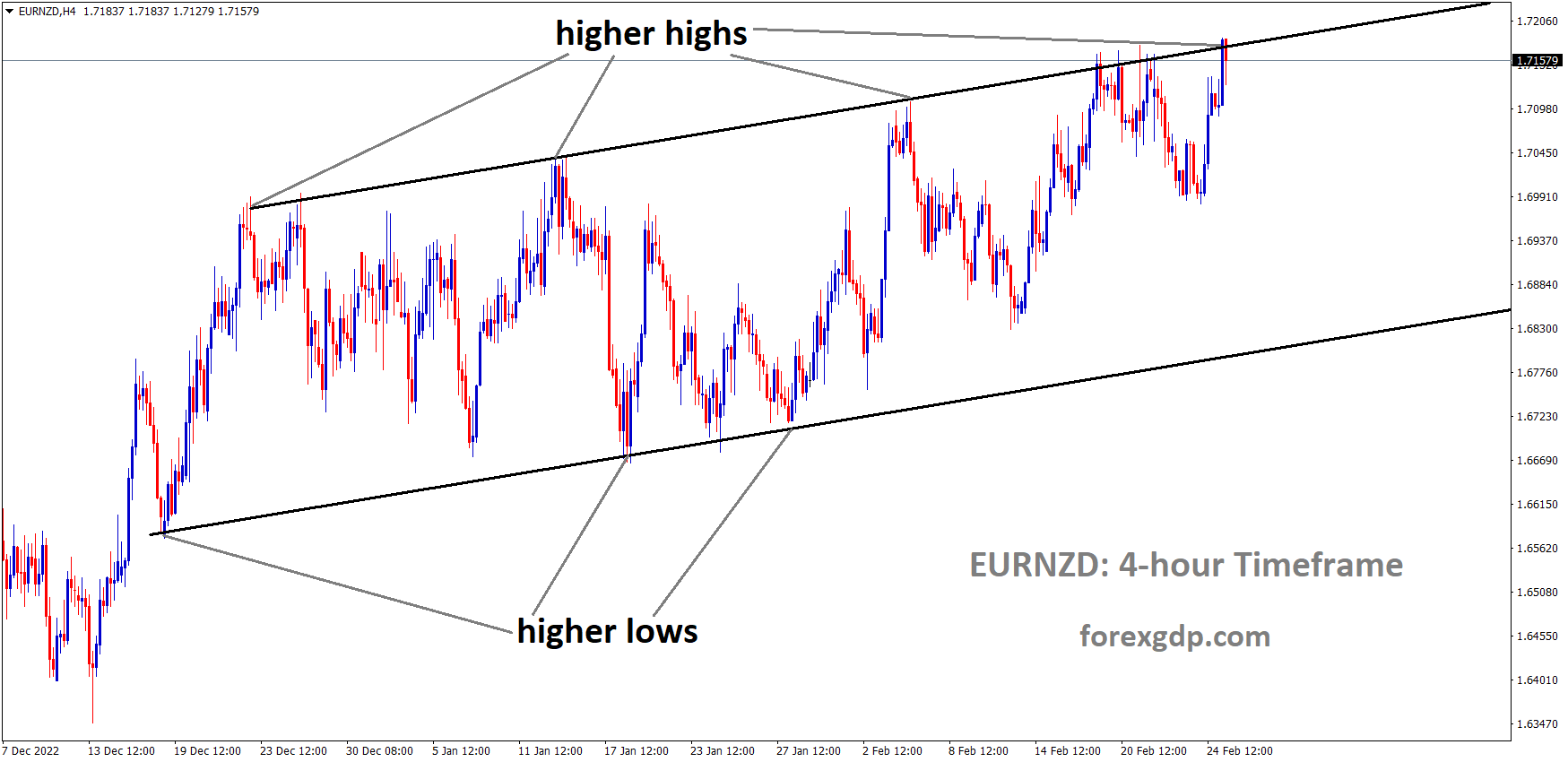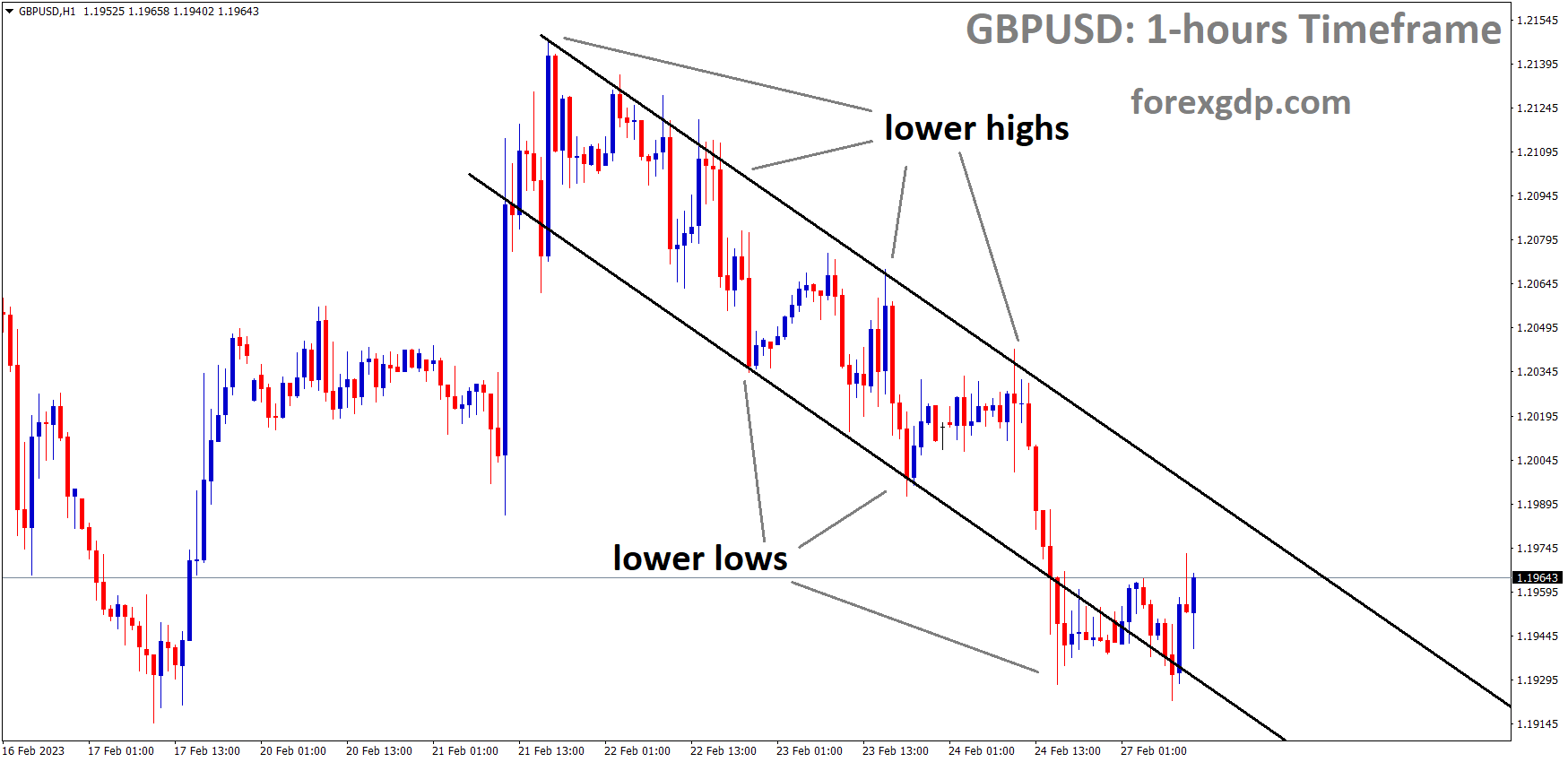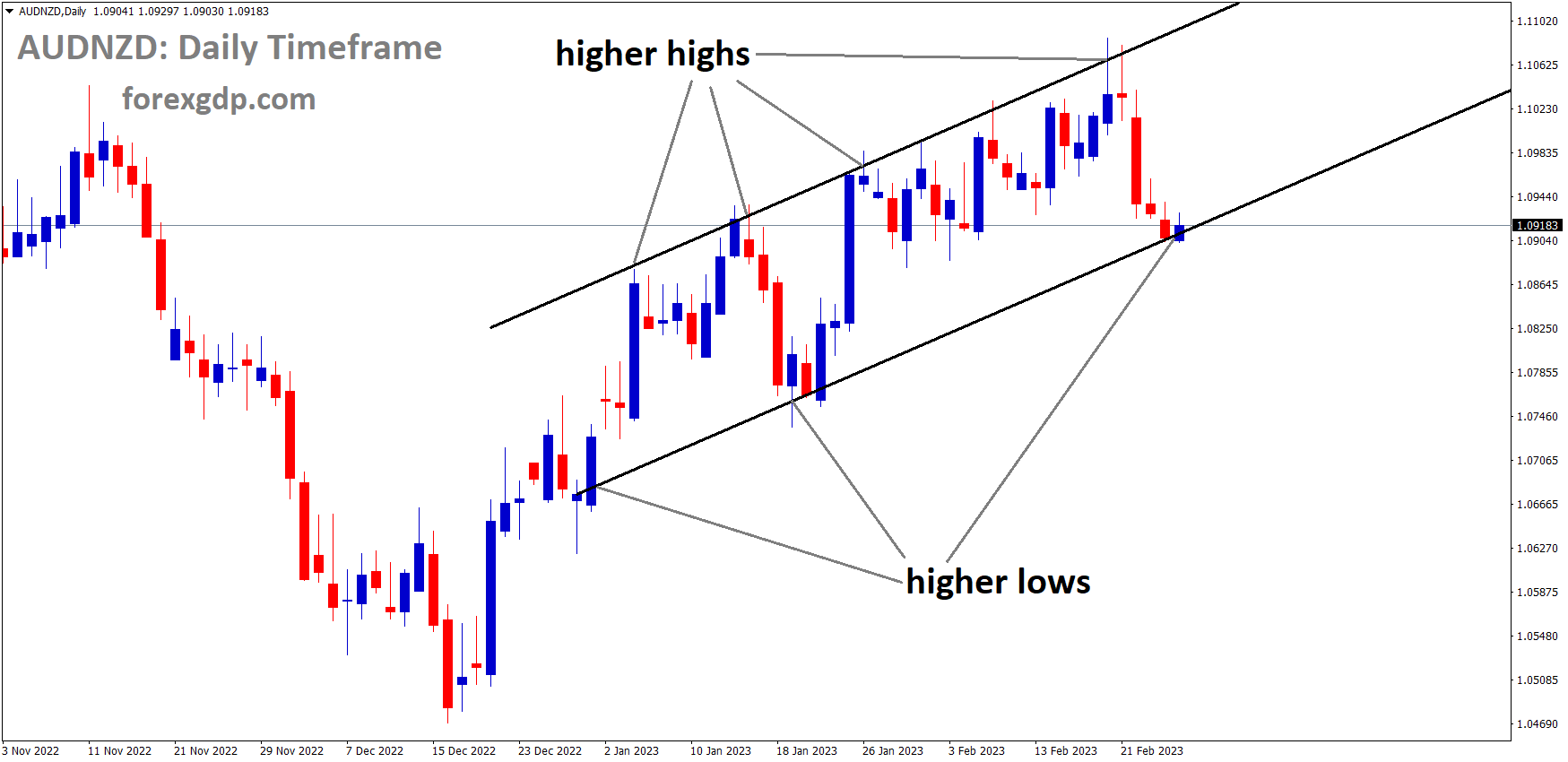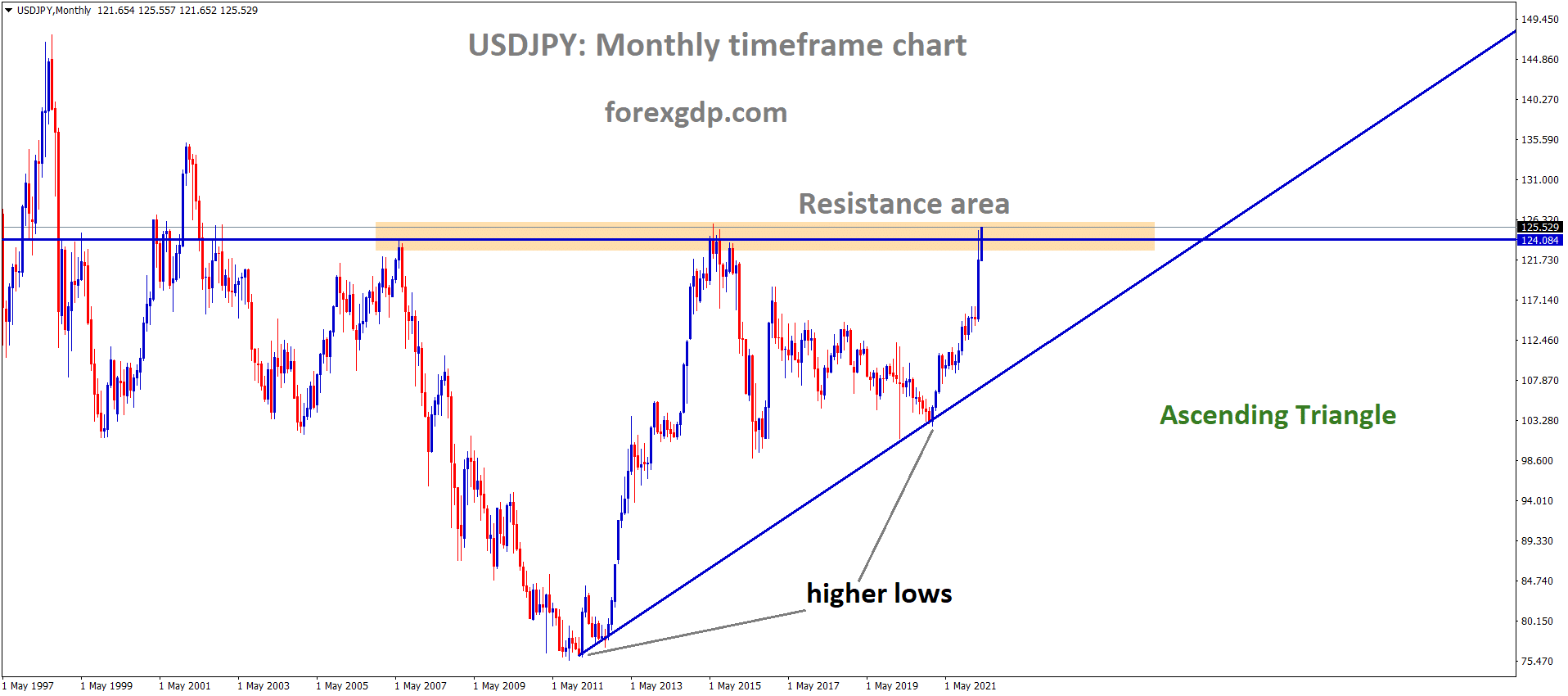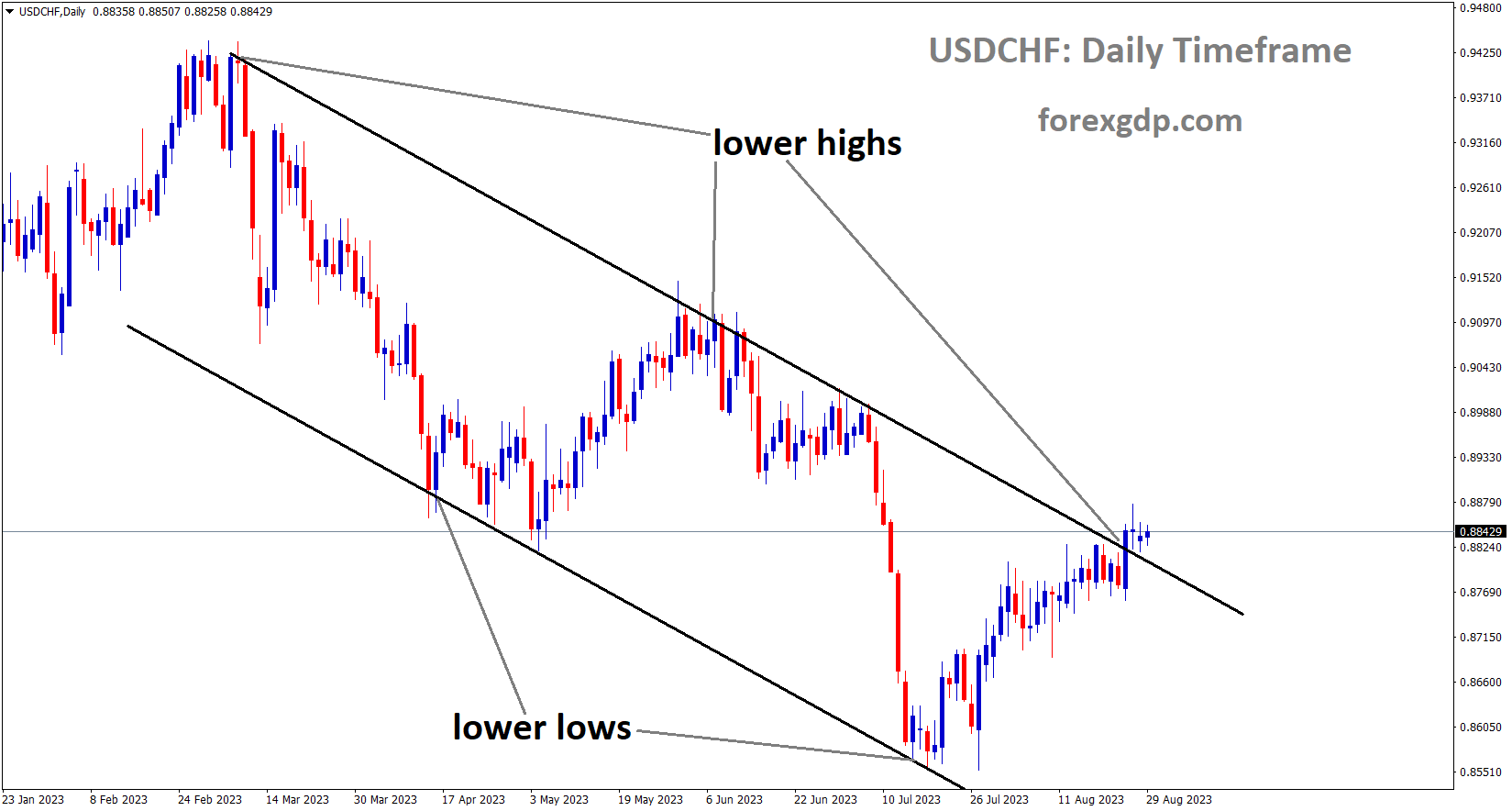EURUSD Analysis
EURUSD is moving in the Descending channel and the market has rebounded from the lower low area of the channel.
Rising inflation expenses and falling household demand have contributed to a 0.4% contraction in the German economy. If Germany continues to contract over the next month, it will be the first indication that a recession has truly begun. To keep inflation below the 2% goal, ECB President Lagarde has indicated that two more massive rate hikes are on the table.
In the absence of supportive fiscal policy, European Central Bank Governor Lagarde has affirmed that the policy tightening spell of 50 basis points will continue in March. “We will do more hikes if required to return inflation to our target of 2% in a timely way,” she reportedly said, as reported by the Economic Times.
The German GDP shrank in the year 2022’s final quarter. Inflationary pressures and the energy disasters appear to have dampened expectations for Germany’s economy. Investors are worried that a further 0.4% decline in the German economy would indicate a recession.
“The second consecutive drop in the Ifo’s current assessment component, a falling manufacturing PMI, weak consumer confidence, and a willingness to spend near historical lows all point to a contraction of the German economy once again in the first quarter,” said Carsten Brzeski, global head of macro at ING.
GOLD Analysis
XAUUSD Gold Price is moving in the Descending channel and the market has rebounded from the lower low area of the channel.
The market has shed an estimated 14.7 tonnes of gold from exchange-traded funds over the past five days, or 3 tonnes per trading day. This is primarily due to the fact that the FED is planning to raise interest rates by 5.35% this summer, which is 50 basis points more than was anticipated. Consequently, Gold ETF investors are gradually shifting their focus from relatively safe investments to those with higher yields.
The price of gold is being hampered on multiple fronts. Gold prices are expected to fall as a result of rising interest rates, according to analysts at Commerzbank. For one reason, gold exchange-traded fund redemptions have been on the rise again as of late. Total outflows over the past five business days came to 14.7 tonnes, or 2.92 tonnes per day.
SILVER Analysis
XAGUSD Silver Price is moving in an Ascending channel and the market has reached the higher low area of the channel.
The biggest and most liquid gold exchange traded fund in the world has also seen outflows in recent months. It had previously seen moderate net inflows over the course of a few weeks, giving rise to optimism that ETF buyers were beginning to return. For the time being, at least, such aspirations appear to have been dashed by the sharp uptick in rate hike anticipation.
The Fed Fund Futures market forecasts that interest rates will reach their highest point of the year sometime this summer, at around 5.35 percent. That’s about 50 basis points more than was predicted in early February. Gold is under pressure as a consequence of the sharp increase in (real) bond yields and the simultaneous appreciation of the US Dollar.
USDJPY Analysis
USDJPY is moving in an Ascending channel and the market has reached the higher high area of the channel.
Kazuo Ueda, the new governor of Japan’s central bank, has stated that he will not implement any austere changes to the country’s historically easy monetary policy. He also made it crystal clear that rising inflation and global economic concerns had led to a loosening of YCC Yield Curve control at recent sessions. If he’s chosen, we may be able to maintain an ultra-loose monetary policy for the next few months.
The US personal consumption expenditures price index, the Fed’s preferred inflation gauge, climbed 0.6% month over month in January, exceeding expectations of a 0.4% increase. On Friday, the USD/JPY and US Treasury yields both increased. Compared to what was predicted, personal expenditure increased by 1.8% in January. The US economy isn’t slowing down fast enough, according to a string of positive data released since the month’s beginning, the most recent of which was Friday’s, indicating that the US Federal Reserve will need to continue raising interest rates for the near future. After Friday’s data, rate futures are pricing in a Fed funds rate peak of around 5.39% in September, up from a peak of barely over 5.3% in July.
To add fuel to the fire, upcoming Bank of Japan Governor Kazuo Ueda dampened expectations of an early end to ultra-easy monetary policy, which helped the US dollar against the Japanese yen. On Friday, Ueda said the central bank must keep the ultra-easy policy to support the economy, but he left the door open to potential tweaks to the yield curve control. Ueda noted that the policy’s unintended consequences, such as a decline in market function, were becoming apparent, and that the BOJ needed to keep an eye on how the steps it made in December, such as expanding the range around its yield target, were affecting the unintended consequences. Considering the potential yield curve distortions the YCC could cause in light of current high levels of inflation around the world and in the United States, the YCC is generally seen as unsustainable.
USDCHF Analysis
USDCHF is moving in an Ascending channel and the market has reached the higher high area of the channel.
The final figures for the US Core PCE Index for the month of January showed an annual increase of 4.7%, giving the US dollar a lift on the market. Fed The countermeasure to rising inflation pressures will be a 25 basis point rate hike over the course of the next three sessions. Mester, James Bullard, and Susan Collins, all members of the Federal Reserve Board, have made recent remarks that can be interpreted as Hawkish.
After a hot core US PCE print on Friday and Fed officials reiterating their hawkishness, the dollar held on to its gains heading into the close of last week.On Friday, the core PCE indicator for the United States came in at 4.7% on an annualised basis through the end of January, which was above the 4.3% forecast and the 4.6% recorded in the previous two weeks. The markets generally agree that this is the Fed’s favoured inflation gauge.The market is cautious to open the week, weighing the impact of the Fed funds rate path on risk assets. The market expects the Fed to raise rates by 25 basis points at each of its next three sessions, bringing the expected peak for this rate cycle to 5.4% from 4.9% at the beginning of the month.The weekend saw a flurry of hawkish remarks from Fed board members Loretta Mester, James Bullard, and Susan Collins.
Yields on U.S. Treasuries have remained near their record highs from last Friday, with the 2-year note once again rising above 4.8%.To mirror the poor showing of US stocks on Friday, most APAC equities are down today. According to the futures market, the upcoming cash session on Wall Street should get off to a relatively calm start.
Australian and New Zealand Dollars have fallen in response to the risk-averse mood on the currency markets, which have otherwise been relatively calm today.The G-20 summit has ended, and participants have not yet agreed on a communique’s language. Both Russia and China took offence at how the conflict in Ukraine was described.Ignazio Visco, Governor of the Bank of Italy and part of the Governing Council of the European Central Bank (ECB), has stated that interest rates will be made as stringent as is required to combat inflation.
On Monday, crude oil contracts continued their upward trend from Friday, with the WTI contract trading near US$ 76 bbl and the Brent contract inching towards US$ 83 bbl. As the price of gold falls towards US$ 1,800 an ounce, investors are getting nervous.Ueda, the arriving governor of the Bank of Japan, testified before the Japanese senate today. He defended the status quo of monetary policy.
EURCHF Analysis
EURCHF is moving in the Descending channel and the market has reached the lower high area of the channel.
Rising inflation expenses and falling household demand have contributed to a 0.4% contraction in the German economy. If Germany continues to contract over the next month, it will be the first indication that a recession has truly begun. To keep inflation below the 2% goal, ECB President Lagarde has indicated that two more massive rate hikes are on the table.
In the absence of supportive fiscal policy, European Central Bank Governor Lagarde has affirmed that the policy tightening spell of 50 basis points will continue in March. “We will do more hikes if required to return inflation to our target of 2% in a timely way,” she reportedly said, as reported by the Economic Times.
The German GDP shrank in the year 2022’s final quarter. Inflationary pressures and the energy disasters appear to have dampened expectations for Germany’s economy. Investors are worried that a further 0.4% decline in the German economy would indicate a recession.
“The second consecutive drop in the Ifo’s current assessment component, a falling manufacturing PMI, weak consumer confidence, and a willingness to spend near historical lows all point to a contraction of the German economy once again in the first quarter,” said Carsten Brzeski, global head of macro at ING.
EURNZD Analysis
EURNZD is moving in an Ascending channel and the market has reached the higher high area of the channel.
Paul Conway, chief economist at the Reserve Bank of New Zealand, predicted that by mid-2023, the OCR rate would be 5.50 percent. If New Zealand experiences an increase in interest rates, consumers will cut back on their spending. A rise in interest rates has only one purpose: to slow rising prices. As borrowing prices rise, we’re seeing demand fall.
On Friday, Paul Conway, chief economist at the Reserve Bank of New Zealand said, OCR is anticipated to peak around mid-2023 at 5.50%. Consumer spending is above projections. My forecast is that spending will decrease as interest rates increase. Demand appears to be starting to level off. The economy still needs to be cooled by higher interest rates. There haven’t been any rumoured proposals to alter LVR caps.Both the New Zealand Retail Sales data and the ongoing risks posed by Russia and Ukraine have eroded investor trust.
GBPUSD Analysis
GBPUSD is moving in the Descending channel and the market has rebounded from the lower low area of the channel.
Dominic Raab, the UK’s deputy prime minister, has said that an agreement on the Northern Ireland Protocol is imminent. As a member of the European Union, the British government has made significant strides. Northern Ireland no longer undergoes border checks with the rest of the United Kingdom.
In an interview with BBC’s Laura Kuenssberg on Sunday, British Deputy Prime Minister Dominic Raab said that the country was “on the cusp” of securing a new Brexit agreement on Northern Ireland.
There had been “significant headway” in the government’s negotiations with the EU. It would be a huge step forward, but we aren’t quite there yet. It would be a huge step forward, but first and foremost, I believe it would mark a paradigm shift for the people of Northern Ireland. It is only fair that there is a democratic check on any proposed new regulations that would apply to Northern Ireland.
The United Kingdom would like to end the practise of inspecting every shipment entering Northern Ireland from the rest of the United Kingdom.
CADJPY Analysis
CADJPY is moving in the Box Pattern and the market has reached the resistance area of the pattern.
The Canadian economy will feel the effects of the Bank of Canada pausing its tightening rate cycles, and worries of a recession will rise in the coming months. Because of the increase in interest rates, the cost of borrowing money to buy oil has increased, causing consumers to reduce their usage and Canada to reduce its exports. As oil prices continue to fall, the US dollar has appeared to strengthen against the Canadian dollar in recent weeks. Due to the possibility of a rate hike at forthcoming meetings, the positive CAD CPI data will be welcomed.
An increase in supplies of crude oil on the first trading day of the week is expected to weaken the commodity-linked Canadian dollar, and concerns that rising interest rates will slow economic development and reduce demand for fuel are expected to outweigh the impact of reduced Russian exports. And this, in turn, isn’t helping Oil prices continue their two-day recovery from Thursday’s nearly three-week bottom.
In addition, the weaker Canadian consumer inflation figures from last week add to the speculation that the Bank of Canada (BoC) will halt the policy-tightening cycle, which weighs on the domestic currency. In contrast, persistently high inflation is likely to prompt the Federal Reserve to maintain its hawkish attitude.
AUDNZD Analysis
AUDNZD is moving in an Ascending channel and the market has reached the higher low area of the channel.
Economics in Australia RBA has reduced its tightening cycle at each meeting, aligning more closely with the inflation and crisis cycle. Both the number of open jobs and the unemployment percentage are at all-time highs. If the RBA wants to forestall a future recession, it must raise interest rates appropriately at forthcoming meetings.
More than one-third of respondents to a Bloomberg poll expect the economy to contract within the next 12 months, up from one-fourth at the end of 2017 when Lowe first hinted at a rate halt. Contrarily, there has been a decrease in the likelihood of a recession in the United States.This about-face comes after the RBA’s initial hesitation in the face of a sharp inflation spike, which has now prompted a bullish reversal and caused markets to factor in four additional rate increases. That’s one hike beyond what the market anticipates the Fed will make.
The Reserve Bank of Australia (RBA) started its tightening cycle in May, two months after the Federal Reserve (Fed), and then proceeded at a more measured tempo. Lowe claimed that Australia was unique amongst developed countries, and that inflation would decrease as a result of supply chains becoming less tangled. The governor stated that a gentle descent of the economy was the goal of the RBA. However, in the last quarter of 2022, inflation reached a 32-year high, supported by rising prices due to robust domestic demand. As Lowe began to realise that Australia faced the same problems as the rest of the globe, he shifted his tone. The markets were caught off guard by his rate hike and hawkish message in February after the RBA had contemplated a pause in December. “The path between containing inflation and recession becomes narrower the longer central banks postpone aggressive action against inflation,” said Stephen Miller, an investment strategist at GSFM headquartered in Sydney. The RBA’s indecision until 2022 has made that window of opportunity much smaller than required.
While the Federal Reserve was still increasing rates by 75 basis points in October, the RBA was among the first central banks to move to quarter-point hikes. Lowe hoped to safeguard some of Australia’s labour market gains at a time when unemployment was near a 50-year low and job openings were at record highs.
Miller argues it would have been preferable to increase rate hike pressure then, rather than now, when unemployment is increasing and the economy has lost jobs in the previous two reports. The market expects the RBA’s final rate to be more than 1% lower than the Fed’s. Consumer confidence has dropped to near-recession levels, adding to the pressure on the RBA to take more drastic measures. While the RBA raised their rates by 3.25 percentage points, US buyers have shown greater resilience.
According to Andrew Canobi, head of Australian fixed income at Franklin Templeton Investment Australia in Melbourne, “increasing anecdotes from some of the corporates” are beginning to corroborate the results of the trust surveys. Domino’s Pizza, for one, has reported that consumers are no longer opting for delivery in favour of in-store pickup to save money. In an interview with Bloomberg Television, Australian Treasurer Jim Chalmers admitted the economy was going to decline “considerably,” but he predicted it would not enter a recession. “I have high hopes for the future. He proclaimed, “We have got a lot going for us.”
Unlike homeowners in the United States, who typically take out loans with 30-year terms and are thus protected from tightening cycles, the vast majority of Australian borrowers are saddled with adjustable-rate mortgages that increase in payment amount every time the central bank raises interest rates. Higher borrowing costs have already contributed to a drop in the Australian housing market, and this trend is expected to continue throughout the year.
In addition, there is the possibility of a rise in interest rates on debts that were fixed for two to three years at historically low levels during the pandemic. Approximately 23% of all outstanding mortgage debt is expected to be re-priced this year, according to RBA data, and in some instances, borrowing costs will more than double to close to 6%. Property consultant CoreLogic Inc.’s director of research, Eliza Owen, is more pessimistic than the RBA about the housing market.
Borrowers in Australia who have locked in low interest rates should brace themselves for a costly realignment. Owen argued that this was one reason why interest rates were going up. This next year and a half will be a real litmus test for the market.
Don’t trade all the time, trade forex only at the confirmed trade setups.
🎁 80% NEW YEAR OFFER for forex signals. LIMITED TIME ONLY Get now: forexgdp.com/offer/

